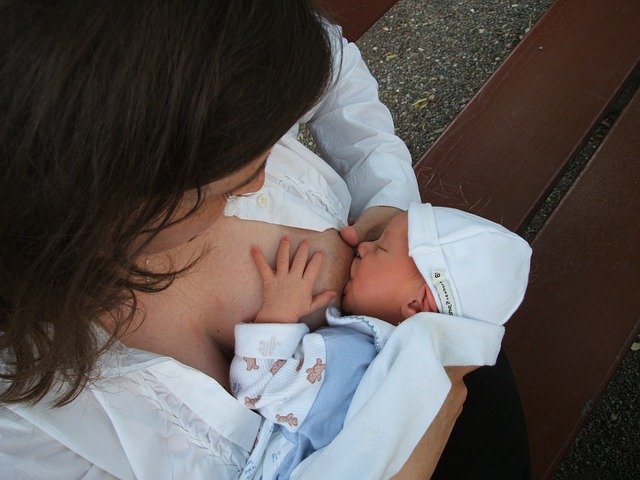Mama Worry: Am I Making Enough Milk?
If a tree falls in the forest, and no one is around to hear it, did it make a sound? If baby feeds from the breast, and I can’t see the milk, is she actually getting anything? There is fear in the unknown, and as if we don’t have enough to worry about, not being able to see and quantify the amount of milk baby is drinking can lead to a constant worry that we’re not producing enough milk for baby to grow and thrive.
Tell me if any of this sounds familiar? You spend 45 minutes nursing baby, only to have him crying and hangry 30 minutes later. Or, you manage to squeeze in 15 minutes of pumping, only to get less than one ounce of output. It’s nerve wracking and frustrating because we just want to KNOW, truly know, that baby is getting everything she needs. So, how do we do that? How can we put our minds at ease that the milk is there even though we aren’t seeing it in a clear container?
What Is Normal?
I can remember scrolling through Instagram and seeing women pumping 12 ounces in a single pump session and thinking, holy crap! Is that what I’m supposed to be getting?!?! (spoiler alert: IT’S NOT)
There is a range of normal, and in the grand scheme of things, the actual quantity of milk that you produce on any given day doesn’t matter. The number itself is somewhat irrelevant. Some days it’ll be more, and some days it will be less, and that is all ok. But when we can’t actually see how much baby is getting, we look at baby to give us clues about whether or not their needs are being met. Chances are, if baby is gaining weight, having enough wet and dirty diapers, and seems satisfied after a feed, then your milk supply is good.
I know what you’re thinking now, though.
Megan, how do I KNOW?! Really KNOW?!?!
Let’s break it down further.
How Much Milk Does Baby Need?
A normal milk supply will vary in the first few weeks after baby is born. After that, it generally regulates to about 25-30 ounces per 24 hour period. For a baby over one month old, who is feeding 8-12 times a day, that’s 2-3.5 ounces per feed.
Let me say that again.
25-30 ounces a day. 2-3.5 ounces per feed.
This is considered normal, and anything over that is considered an oversupply (which honestly, can have it’s own issues). It’s different for a baby under one month old, but just so we’re all clear here. You do not need to have a flowing fount of milk in order to meet your baby’s needs.
Now, for a newborn on their first day on the outside, you are not producing mature milk. What you are producing is colostrum, which is a powerhouse of nutrients. Babies don’t need much, and honestly, can’t handle much, because their bellies are so small. This is why newborns feed ALL.THE.TIME. (and also because they’re trying to build your supply, but that’s a different story). A one day old baby eats about 2 ounces of colostrum for the entire day.
Somewhere between 3-5 days postpartum, mature milk will come in. Then baby will start taking around 8-10 ounces per day. By one week, they’re at 15 ounces, and by 2 weeks, it’s around 20. So, milk production really ramps up in the first couple of weeks. And yes, there are some women who produce way more than the 25-30 ounces needed. And there are some who produce less. But when talking about what is normal and what is necessary, more is not better. 25-30 ounces is not “just enough”. It is exactly what baby needs.
Your Breast Pump is a Liar
Do not judge your supply based on what you pump.
Did you hear me?
Do not judge your supply based on what you pump.
I get it. I’ve been there. I have hooked myself up to those machines time and time again and stressed over how much (or not) was coming out. I’ve counted ounces in my freezer stash and done the math to determine how long it would last.
More to the Story
Here’s the thing. Again, those numbers are arbitrary. How much you pump at any given time only gives you a snapshot of what’s going on in the moment. You have more or less milk depending on the time of day, depending on on how much sleep you get, depending on when baby last ate and how much baby last ate, and on and on and on. There are many different factors that go in to milk production, and they will all impact supply. Even if you are an exclusive pumper, or always pump at the same time every day, you can expect to get varying amounts. Do not let the pump convince you that you’re not making enough milk.
But again, we’re talking about what’s normal here. So what is a “normal” amount to pump? There are no hard and fast numbers here, because there are so many factors impacting supply. There are, however, some general guidelines you can use to give you an idea. You make the most milk from 2am to 4am, so if you’re pumping in the middle of the night (which I highly recommend if baby isn’t waking to feed at regular intervals) expect to see more milk than you would normally. Likewise, supply tends to be higher in the mornings and lower in the evenings (which is why babies like to cluster feed in those few hours leading up to bedtime).
How Much?
If you’re like me, though, you want numbers. I’m a math and numbers girl, so I get it. How much should you expect to pump? Rule of thumb is, if you are pumping to replace a feed (as in baby has not eaten in 2-3 hours), expect to pump the equivalent of a normal feed. Remember, a normal feed is about 2-3.5 ounces. That’s combined, by the way, NOT from each breast.
If you have been away from baby for longer than 2-3 hours, you can expect roughly 0.75-1 ounce per hour away from baby, but only to a certain extent. As the breast fills, milk production slows down. Therefore, it won’t always be a 1:1 ratio, especially the longer it’s been since the breast has been emptied.
If you are pumping after baby has just fed, do not expect to get much, IF ANYTHING, from pumping. Think of it this way. Baby has just had a full feed from you and now you’re pumping. Anything that is left over is extra. Half an ounce combined would be completely normal.
A Machine is not a Baby
One other reason that your pump is a liar is that your pump is still a machine. It will not be as efficient at removing milk as an effectively latched baby would be. All the technology in the world can not replicate the way a baby expresses milk. Some women do not respond to pumping, and will always struggle, despite having adequate supply. Also, as a machine, it’s effectiveness depends on properly fitted and functioning parts, as well as user competency. Something as simple as a worn out valve can drastically decrease the amount of milk you might get, and there is definitely a learning curve to using a breast pump. User error can account for much when it comes to technology.
But Am I Making Enough Milk?
Ok, so some of you might still be yelling at the computer, waiting to be reassured that baby is getting enough milk. So how do you know?
Diapers
The first way to tell if baby is getting enough milk is from how many wet and dirty diapers they have. A newborn baby on the first day will have one wet diaper, and maybe one dirty diaper. Day two is two wet and two dirty, day three is three wet and three dirty, etc. Once mature milk has come in (in that 3-5 day postpartum window), expect a wet and dirty diaper after every feed. Yes, 8-12 dirty diapers a day. To truly be considered a dirty diaper stool should be at least the size of a quarter.
Weight Gain
Also, baby should be gaining weight. You will see your baby’s pediatrician multiple times in that first month, and weight checks are an important data point. It is expected that baby will lose weight in the first days after birth before the mature milk comes in. A weight loss of around 7% is expected. Around a 10% weight loss is where your doctor might start to get concerned.
But generally speaking, if you have an adequate supply and baby is effectively latching, baby will regain their birth weight within 10-14 days. Doctors like to see a weight gain of around 1 ounce per day. Baby should also generally follow their growth curve. Where they are on that curve in terms of their percentage is less important than whether or not they are maintaining their curve. So don’t be alarmed if baby has a low percentage. It’s much more concerning if baby starts high and then drops, and drops, and drops.
But, you’re probably not weighing your baby every day, so what can you do at home to reassure yourself that baby is getting what they need.
Demeanor
Look at your baby.
What does a well fed baby look like? That baby has the energy to wake up. He engages in vigorous feeding for 5-30 mins, 8-12 times per day. She appears satisfied after feeding, relaxed, content. Baby’s hands are open, not clenched shut. She may want to feed again in 30 minutes or an hour, but if baby is settling in between feeds and seems content, then that is a good sign.
What things DO NOT indicate a low supply? Breasts feeling soft or deflated, frequent feedings, longer feedings, shorter feedings, low pump output, breasts not leaking, frequent night wakings, baby fussing at the breast, and most importantly, baby’s willingness to take a bottle after breastfeeding. Babies love the fast flow of a bottle, and even if full, they will suck that bottle down. It does not mean you have low milk supply.
The Big Picture
It is super stressful knowing that the little creature you created is entirely dependent on you. Understanding what is normal and managing expectations appropriately can help to ease that worry. A normal milk supply is only 25-30 ounces per day. If you are pumping to replace a feed, 2-3.5 ounces combined is a normal output. Don’t expect more than drops if you’re pumping just after baby has fed. A baby that is receiving enough milk is content, relaxed and satiated. They have enough energy throughout the day to wake themselves repeatedly to feed. Hopefully this information has helped you gain a better idea of what is normal and allowed you to be more confident in knowing that you are providing what your baby needs.
Milk on, Mama





